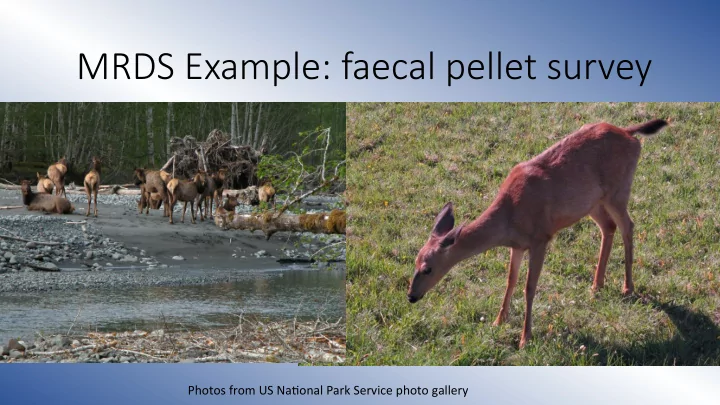

MRDS Example: faecal pellet survey Photos from US Na.onal Park Service photo gallery
Pellet survey design • Survey of faecal pellets of elk and deer in Olympic Na.onal Park, Washington, USA, to es.mate abundance: • Double observer line transect survey to es.mate abundance of pellets incorpora.ng percep.on bias • Plot clearing experiment to es.mate deposi.on/decay rates of pellets • Stra.fied random sampling was used to select sampling units • Region (East;West); eleva.on (<300m;>300m); accessibility (<1km from road;<1km from hiking trail;>1km from road or trail) • Within each sampling unit, 2 parallel transects 200m in length were selected • Two observers worked independently and walked along each of the transects ( observer 1 ) looking for faecal pellet groups within 2m of centre line • Collected informa.on on pellets – perpendicular distance, number of pellets, dispersion, condi.on • And environmental condi.ons – ground cover, substrate • Observers swapped transects ( observer 2 ) and repeated survey • Reconciled which pellet groups had been seen by observer 1 only, observer 2 only and by both observers • References • Jenkins KJ and Manly BFJ (2008) A double-observer method for reducing bias in faecal pellet surveys of forest ungulates. J. App. Ecol. 45, 1339-1348 • Burt ML, Borchers DL, Jenkins KJ and Marques TA (2014) Using mark-recapture distance sampling methods on line transect surveys. M. E. E. doi: 10.1111/2041-210X.12294 Appendix S2: Running an MRDS analysis is Distance and R: a tutorial
Fi=ed models: IO configuraBon MR model: distance + sizegroup DS model: hazard rate, no covars Obs 1 | Obs 2 Obs 2 | Obs 1 1.0 1.0 1.0 Detection probability 0.8 0.8 0.8 Detection probability Detection probability 0.6 0.6 0.6 0.4 0.4 0.4 0.2 0.2 0.2 0.0 0.0 0.0 0 50 100 150 0 50 100 150 0 50 100 150 Distance Distance Distance Point independence = DS + MR Full independence = MR 1.0 0.8 Detection probability Detection probability 1.0 0.6 0.8 0.6 0.4 0.4 0.2 0.2 0.0 0.0 0 50 100 150 0 50 100 150 Distance Distance
EsBmates of detecBon probability Point independence Full independence Es6mates Model used Es6mate Model used Es6mate Probability of detec.on assuming g(0)=1 DS 0.69 (0.03) - Probability of detec.on on the trackline MR 0.94 (0.01) MR 0.94 (0.02) Overall probability of detec.on MRDS 0.65 (0.03) MR 0.86 (0.02) Es.mated N in covered region 2116 (0.04) 1601 (0.02)
DetecBon funcBon summary: IO point independence DS model Summary for io.fi object MR model Summary for ds object assuming g(0)=1 Number of observations : 1380 Pooled Number of observations : 1380 Number seen by primary : 1094 Observer 1 Distance range : 0 - 150 Number seen by secondary : 1102 Observer 2 AIC : 13612.95 Number seen by both : 816 Duplicates AIC : 2457.952 Detection function: Hazard-rate key function Conditional detection function parameters: estimate se Detection function parameters (Intercept) 0.28098736 0.188557908 Scale coefficient(s): distance -0.00835025 0.001517454 estimate se sizegroup2 0.46927834 0.207238009 (Intercept) 4.425513 0.05855335 sizegroup3 1.78569572 0.193560108 sizegroup4 3.19715740 0.440773795 Shape coefficient(s): estimate se Estimate SE CV (Intercept) 0.6851006 0.1247415 Average primary p(0) 0.7952424 0.017075328 0.02147185 Average secondary p(0) 0.7952424 0.017075328 0.02147185 Estimate SE CV Average combined p(0) 0.9416874 0.009603405 0.01019808 Average p 0.6924608 0.02190796 0.03163784 Summary for io object MRDS model On the trackline Total AIC value : 16070.9 = 2457.952 + 13612.95 Overall distances Estimate SE CV 𝑂 ↓𝑑𝑝𝑤𝑓𝑠𝑓𝑒 = Average p 0.6520816 0.02167574 0.03324085 1380 / 0.652 N in covered region 2116.2996331 78.02162494 0.03686700
DetecBon funcBon summary: IO full independence Summary for io.fi object MR model Number of observations : 1380 Pooled Number seen by primary : 1094 Observer 1 Number seen by secondary : 1102 Observer 2 Number seen by both : 816 Duplicates AIC : 16217.81 Conditional detection function parameters: estimate se (Intercept) 0.28098736 0.188557908 distance -0.00835025 0.001517454 sizegroup2 0.46927834 0.207238009 sizegroup3 1.78569572 0.193560108 sizegroup4 3.19715740 0.440773795 Estimate SE CV Overall distances Average p 0.8617999 0.014769988 0.01713854 𝑂 ↓𝑑𝑝𝑤𝑓𝑠𝑓𝑒 = Average primary p(0) 0.7854780 0.015519397 0.01975790 1380 / 0.862 Average secondary p(0) 0.7854780 0.015519397 0.01975790 On the trackline Average combined p(0) 0.9368971 0.009788271 0.01044754 N in covered region 1601.2998003 32.267117776 0.02015058
Recommend
More recommend